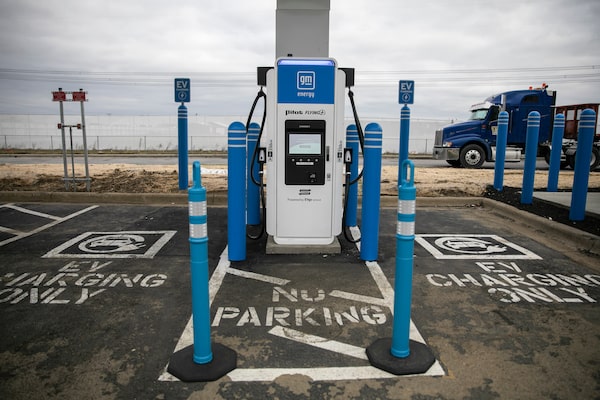
An electric vehicle charging station in London, Ohio, on Dec. 11, 2023.MADDIE MCGARVEY/The New York Times News Service
Most investors and politicians are aware that the transition to electric vehicles will require huge investments in battery technology and infrastructure.
As a result, any corporate press release that includes the words lithium, cadmium and batteries in the same paragraph will almost certainly result in a boost to the stock price and an offer of financing from three levels of government.
But, EVs also require traction motors to move them and this, too, represents a huge potential market that offers niche investment opportunities.
So, I was surprised to discover that one of the companies featured in my Nov. 21, 2023, article on stocks trading below net-net working capital claims to be a potential beneficiary of the transition to EVs. Neo Performance Materials Inc. NEO-T does not manufacture batteries or electric motors, but it does process rare earths and transforms the material into magnets used in many types of electric motors, not just traction motors for cars.
The surprise came because the net-net working capital screen identifies companies in which the stock price trades below the value of the current assets less all liabilities – essentially the liquidation value of the business. Most companies that appear on this screen have minimal growth prospects and occupy a mature industry sector, which does not appear to be the case for Neo Performance. Clearly, this stock is either a bargain or investors have some reason to be skeptical about the company’s self-proclaimed market position.
According to the Toronto-based company, it has 30 years of magnetics experience inside and outside of China. This is important because 85 per cent of all traction motors for EVs use motors driven by rare earth magnets and 90 per cent of global rare earth magnetics are produced in China today. Each EV traction motor uses one to two kilograms of rare earth magnets at US$80 a kilo, so this is not a trivial manufacturing input.
The dependence on China for rare earth technology does not sit well with European and North American automobile manufacturers and governments, which has resulted in pressure to diversify the sources of supply. Neo Performance is able to serve customers from its operations in China, but it also creating a parallel supply chain from a new plant in Estonia.
Production of magnets is the high-margin, rapid-growth opportunity for the company, but today’s investors are more concerned about the volatility of revenue and earnings from the commodity side of the business – processing and recycling. This sector has had a negative gross margin swing of US$40-million over the past two years alone, so analysts are understandably reluctant to place much confidence on their earnings forecasts.
Another concern may be that the company still has more than US$60-million of remaining capital expenditure requirements to complete the rare earth magnet plant in Europe, which will deplete much of the current cash balance. After that, there will be pressure to establish a similar facility in North America at a time when governments may be tightening their purse strings.
With that as background, it is understandable that Neo Performance stock would trade at a discount to its growth potential, especially as this is not a new story. The stock, which traded at about $6 a share this week, was above $20 in October, 2021. Investors then presumably were also seduced by the rare earth story and the transition to EVs, but have been disappointed by recent results: revenue is barely 6 per cent ahead at US$570-million and earnings per share have swung from a profit of 91 US cents to a loss of 19 US cents. Despite this, the dividend remains intact at 40 cents, for a generous yield of 6.6 per cent.
At a recent presentation hosted by the Genesis Club, management insisted that the potential from rare earth magnets remains extremely positive and that they are moving to reduce the volatility from the commodity side of the business. Also, the growth in the magnet demand for EVs has been masked by a decline in the legacy business such as computer hard drives.
Both the chief executive and chief financial officers are sizeable and recent insider buyers, which is a testimonial to their confidence – and perhaps why the dividend remains intact. I am a sucker for net-net working capital stocks, so I, too, own some shares.
Note that the stock price trades in Canadian dollars, but the financials are in U.S. dollars, so be sure to gross up the balance sheet numbers when calculating ratios.
Robert Tattersall, CFA, is co-founder of the Saxon family of mutual funds and the retired chief investment officer of Mackenzie Investments.
Be smart with your money. Get the latest investing insights delivered right to your inbox three times a week, with the Globe Investor newsletter. Sign up today.
 Robert Tattersall
Robert Tattersall